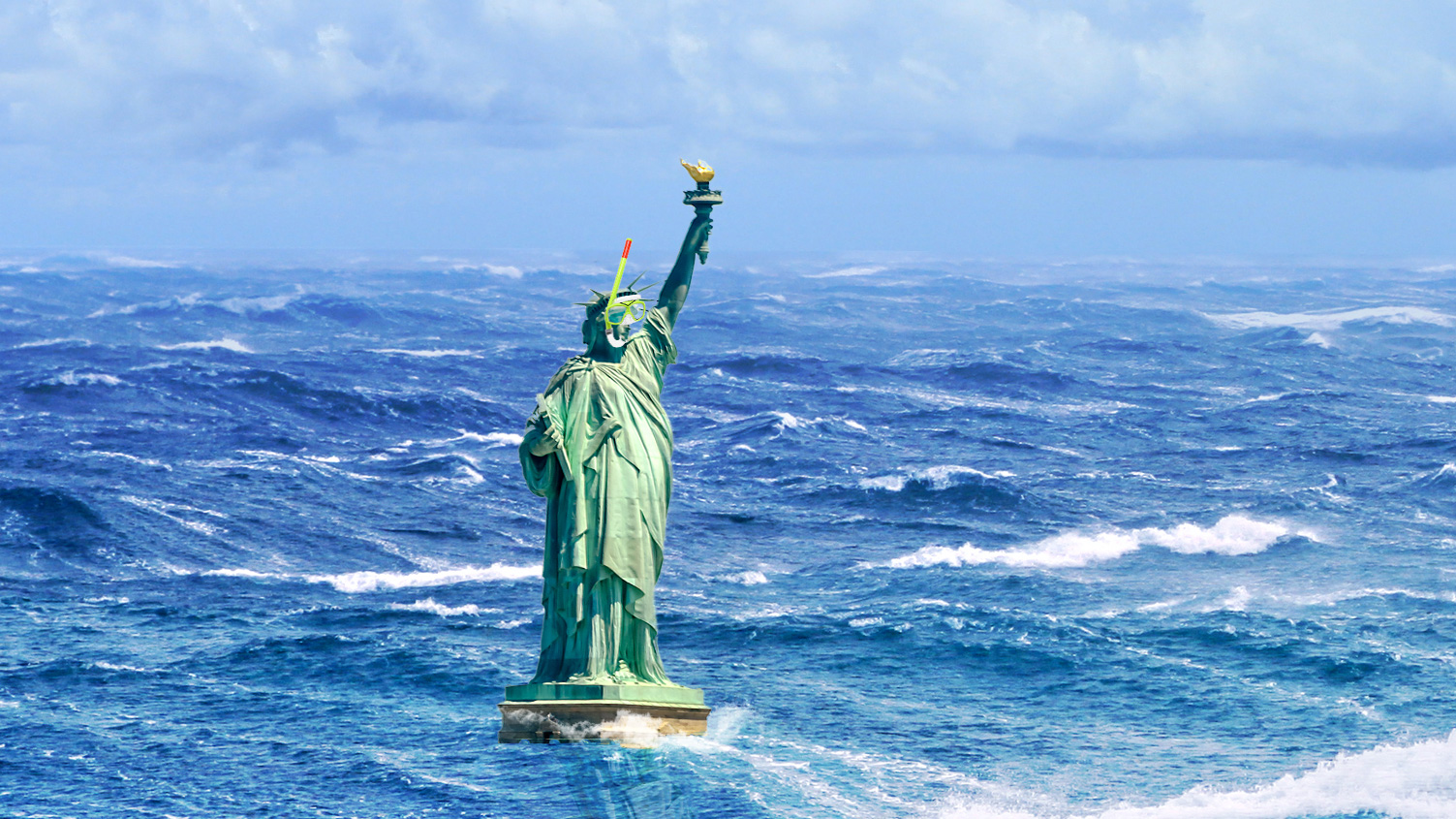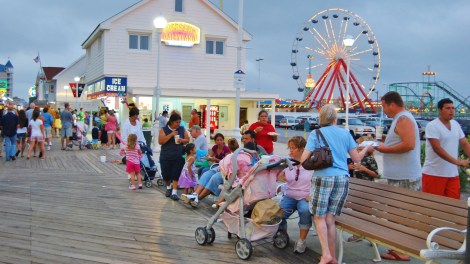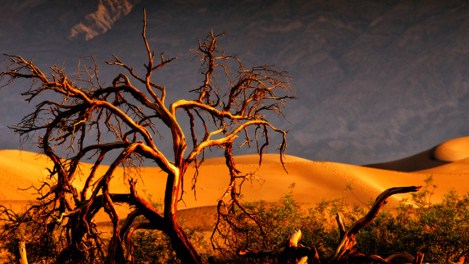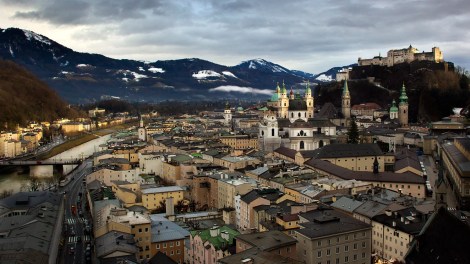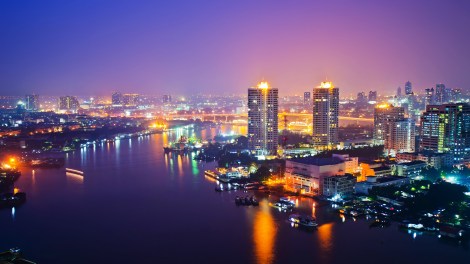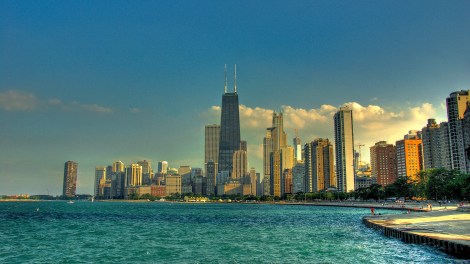Summer is just around the corner and, after a winter like this one, it’s high time to start making those vacation plans. Of course, our buoyant spirits were somewhat dampened by the latest U.N. climate report. Spoiler alert, it wasn’t real good, well, unless you’re into horrific droughts, monster storms, heat waves, mass extinctions, failing crops, dogs and cats living together, mass hysteria, in which case, jackpot!
Ever the troopers, we here at Grist decided to not let the bad news harsh our fantastic inner mellow and instead to look at this as a crisitunity. Usually picking vacation spots is such a challenge, but by focusing on the best places that may not be places much longer in our warming world, we were able to shorten our list to the top ten do-it-now vacation destinations. So get ahold of your travel agent, load up the family truckster, and set a course for fun!
1. Ocean City, Md., U.S.A.
With its iconic boardwalk littered with enough Candy Kitchen chain stores to ensure you’re never more than 18 feet from a saltwater taffy fix, Ocean City is the quintessential American beach town. Sadly, like the rest of our seaside getaways, Ocean City faces a terrifying threat: frat boys. Oh, and also rising seas. Sea levels in the mid-Atlantic are expected to rise at least 3.5 feet in the next century, which may not sound like a lot if you’re a giraffe or say, Shaq, but Ocean City is just seven feet above sea level. Our coastal resorts, like our man-on-the-street reporters, are living on borrowed time, and without them, where will our children go to drink beer and make terrible decisions?
2. Great Barrier Reef, Australia
If you’re going to visit a barrier reef, why settle for second best? Sure you could go to the Average Barrier Reef, or even the Pretty Good Barrier Reef, but why, when we’ve got the Great one? Plus, the Great Barrier Reef is measured in hectares, 34 million of them to be specific, and when else do you do anything by the hectare? Never, that’s when. The Great Barrier Reef is visible from space, but best seen close up, and soon. Carbon-driven ocean acidification threatens all the world’s reefs and the largest is hardly immune. High ocean temperatures cause coral bleaching which can hit reefs fast and hard with devastating effects.
If those global threats to the reef, weren’t enough, Australian Prime Minister Tony Abbott, who has some interesting ideas on climate change, has approved a massive dredging project to expand a coal port just outside of the Great Barrier Reef Marine Park with the silt to be dumped on the fragile coral. Not only will the increased shipping traffic threaten the reef directly, that extra 70 million tons of coal a year belched into the atmosphere probably won’t help the reef much either. Of course there is one hope: a plan to ship uranium across the reef. A well-placed nuclear spill could create a Godzilla like defender of the reef and, for extra points, make night diving even more beautiful than cosmic bowling. Of course, it could just be a disaster.
3. Death Valley, Calif., U.S.A.
OK, so Death Valley may already be a pretty terrible vacation destination. It’s home to the highest temperatures on the planet, flash floods, sand storms – and making matters worse, the valley apparently hired the same PR firm that named neighboring Poison Canyon, Calif. It’s so bad even the rocks are trying to leave. If you’re the type that’s always wanted to boil a chicken in your undershorts perhaps a refreshing dip in Furnace Creek is right for you, but do it now.
Temperatures in the park are predicted to rise over 8 degrees F in the next century, and 143 degrees sounds unpleasant. Even a slight temperature increase could drive unique Death Valley species to extinction, reduced precipitation (apparently it’s possible), and turn the park’s Lake Badwater to Lake Nowater. Paradoxically, climate change could also whip up more powerful thunderstorms, sparking devastating wildfires. On the bright side, it’ll still have the world’s finest borax museum and if you’re feeling nostalgic, rising temperatures will make Joshua Tree the new Death Valley.
4. Salzburg, Austria
We all know the snowcapped mountains are going to be a little less snowcapped as the rain/snow line in the Alps has already climbed 200 feet in the last 50 years, but those beautiful flowering alpine meadows that drove Julie Andrews to song should still be enough to drive the tourist trade. Sadly, climate change could spell their doom. While climate change is lengthening the wildflower season in the Rockies, many plant species are already disappearing from Southern European peaks, and the effects will move north. Austria’s beautiful and fragile high altitude flora, already struggling with the reduced snowpack, now face an invasion of hearty and prolific plants climbing from lower elevations to escape the heat. Here’s hoping the sound of music is enough to make those hills feel alive.
5. The Statue of Liberty
Unless you want to see Lady Liberty with her skirts hiked up to avoid the flooding, now is the time to visit. New York is going to have a tough time, with rising temperatures to match the sea levels coming hand-in-hand with insane weather. And the Statue of Liberty stands, nervously, a mile south of Manhattan and right in the path of any future super storm headed for the Big Apple. When Sandy walloped the City that Never Sleeps (possibly because it is afraid of killer storms), nearly all of both Liberty Island and Ellis Island were underwater and the infrastructure was devastated. Even with a massive federal effort, she was closed for over eight months and one study predicts that by 2050, a storm bigger than any we’ve ever seen so far will hit the mid-Atlantic every 10 years! Of course the worst part for Lady Liberty is that she’s so famous, and if disaster movies have taught us anything, calamities aim for famous stuff.
6. Michoacán, Mexico
Forests are nice. So are mountains. Forested mountains are doubly nice. Just ask the billion or so (yes, with a “b”) monarch butterflies that vacation at the Monarch Butterfly Biosphere Reserve each winter. The monarchs come to Michoacán from as far as the Canadian border, traveling nearly 2,500 miles. There are so many butterflies, their weight bends the branches of mighty trees. Just imagine every inch of every surface covered in butterflies. Butterflies underfoot. Butterflies fluttering in your hair. Butterflies bouncing off of your face. Accidentally ingesting butterflies. Being relentlessly pursued by butterflies. Having nightmares for months afterwards about butterflies. Living in constant fear of where the Monarch will strike next.
OK, maybe not all that it’s cracked up to be, but pretty soon, you may have no choice but to imagine it. Monarch populations have been on the decline for 20 years with a record low of just 60 million arriving this winter. Deforestation of their Mexican preserves is a major problem, as is habitat loss and pesticide use in the U.S. To make matters worse, severe weather along their migration route the last two years has hammered the gossamer beasties, and those kinds of events are becoming all too common in this warm new world. And even without the chain saws, the oyamel fir trees that the Monarchs depend on can’t take the heat and are vanishing fast from Mexico’s cloud forests. And if that weren’t enough, it turns out monarchs depend on temperature signals to tell them when to head north again, and as temperatures warm, Monarchs could miss their exit.
7. Everglades, Fla., U.S.A.
Over a million people a year visit the Everglades National Park in sunny Florida, hoping to meet an alligator, ride an airboat, see one of the ugliest mermaids in the galaxy, and perhaps seeing Florida Man in his natural environment. Stretching across 734 square miles of flooded grassland, cypress swamp, mangroves, pine forest, and tropical hardwoods, and providing clean, naturally filtered water to the third largest reef system in the world, the glades should be on every traveler’s bucket list. Unfortunately, we’ve been draining them for well over a century with canals cut through the wild lands providing fresh water for much of South Florida’s enormous agriculture industry and the aquifers being tapped to quench the thirst of the millions of people now living in South Florida. The glades have shrunk to half their size in just the last 50 years and climate change isn’t going to help.
Climate models predict less rainfall for the glades and rising temperatures will boil away what water remains making a dire situation somehow worse. As the glades recede, the ocean takes its place, and with sea levels expected to rise 1.5 meters by 2060, the Everglades could dry up on one end and fall into the sea on the other. So get down there and see this global treasure while it and its noble Florida Man are more than just soggy memories.
8. Bangkok, Thailand
According to Time, Bangkok is the world’s No. 1 tourism spot, with close to 16 million visitors in 2013. It’s good they’re acting now, because by 2030, less than 20 year’s time, the massive city of over 8 million could be gone. Like all of Asia’s coastal cities, Bangkok faces more powerful typhoons and rising seas, but it doesn’t help that the city is also sinking. Home to architectural treasures, world class cuisine, legendary nightlife, and the world’s most successful chess-based musical, this world capital is already being hammered by frequent, massive floods. At the same time, powerful droughts, once rare, are tag-teaming to empty Asia’s Rice Bowl. So pack your bags now, because in short order, one night in Bangkok will not only make a man humble, it will also make him incredibly damp.
9. Chicago, Ill.
The worsening summers in Chicago are so hot they cook deep-dish pizzas on the sidewalks from the Fourth of July through Labor Day, and the lake effect snows, already bad enough to turn the city into a live action Game of Thrones role playing event through much of January, look to get worse, but the Windy City should still make a solid vacation spot. Instead of artisanal pork, Chicagoans may have to substitute a bit of Soylent Green, but there will still be brats. One thing that will go the way of the dodo, however, is the Heartland Institute, the conservative (non) think tank, and its strident denial of climate change. (It’s all a U.N. plot, don’t ya know?) The group’s willful insanity would almost be adorable if it weren’t so damn evil, but even its well-heeled anonymous benefactor (who I am sure is not either of the Koch brothers) will have to give up when reality hits. So skip Mickey Mouse and head to Chi-Town now and get a picture posing with a genuine climate denier.
10. The Sheep Heid Inn, Edinburgh, Scotland
If the Sheep Heid Inn isn’t on your travel list, you need to rethink your priorities. The oldest bar in Edinburgh has been selling booze since 1360, which makes it perhaps the best place on the planet to enjoy the greatest thing human hands have ever crafted: scotch whiskey. I hate to be the one to tell you, but scotch is in trouble! Pour yourself a drink while I explain. Climate events have been hammering Scotland’s distilleries in recent years. Winter floods, summer droughts, and even sand storms make barley crops a role of the dice, and limit the clean, abundant water needed for distilling. Unpredictable weather off the coasts can play havoc with the islay distilleries and then there’s the peat problem. Peat only forms in a very narrow climate window and, according to the International Peat Society, demand for new energy sources could drive industry to once again burn peat for power. Did I mention there’s an International Peat Society? So get your self to the Sheep Heid for a tumbler of the good stuff because we may be forced drink away the apocalypse with – shudder — gin.

